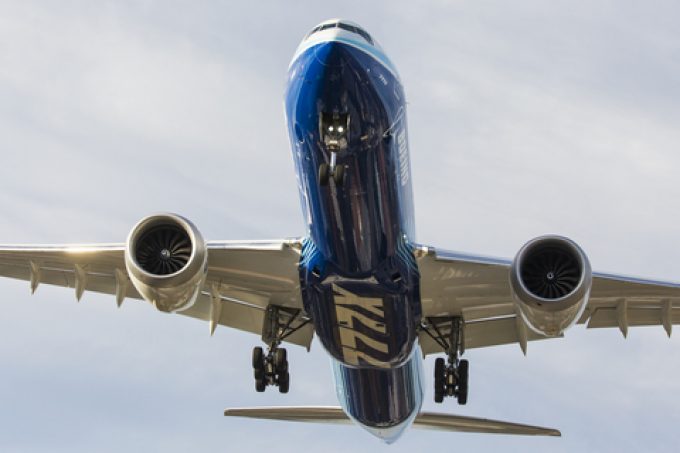Airfreight rates ex-Asia 'surprisingly strong' through traditionally low period
Airfreight rates out of Asia continue to harden – despite a brief fall around US ...
TFII: SOLID AS USUALMAERSK: WEAKENINGF: FALLING OFF A CLIFFAAPL: 'BOTTLENECK IN MAINLAND CHINA'AAPL: CHINA TRENDSDHL: GROWTH CAPEXR: ANOTHER SOLID DELIVERYMFT: HERE COMES THE FALLDSV: LOOK AT SCHENKER PERFORMANCEUPS: A WAVE OF DOWNGRADES DSV: BARGAIN BINKNX: EARNINGS OUTODFL: RISING AND FALLING AND THEN RISING
TFII: SOLID AS USUALMAERSK: WEAKENINGF: FALLING OFF A CLIFFAAPL: 'BOTTLENECK IN MAINLAND CHINA'AAPL: CHINA TRENDSDHL: GROWTH CAPEXR: ANOTHER SOLID DELIVERYMFT: HERE COMES THE FALLDSV: LOOK AT SCHENKER PERFORMANCEUPS: A WAVE OF DOWNGRADES DSV: BARGAIN BINKNX: EARNINGS OUTODFL: RISING AND FALLING AND THEN RISING

Boeing’s inability to deliver new 777-200 freighters is crimping carrier capacity to meet the strong demand, especially in the transpacific market. And freighter conversions are also hobbled, owing to rising passenger demand.
Boeing’s woes spread from its 737 and 787 lines to the 777 freighter segment. It produced six 777-200Fs in March, but none could be delivered and they joined five others sitting at Boeing’s facility in Everett, waiting for engines.
The 11 ‘gliders’ (as the engineless planes are referred to) are not Boeing’s fault, said Stan Wraight, president and CEO of strategic aviation consultancy and training firm SASIWORLD. They are the result of manufacturer GE’s struggles to ramp up engine production, which has been crippled by persistent labour and parts shortages.
“An engine overhaul takes 90 days, but it takes a year to get a slot,” he said.
The problem has been exacerbated by the fact that airlines deferred maintenance work during the pandemic, when cash reserves were low, added Mr Wraight, adding that further pressure on the engine sector had come from problems with Pratt & Whitney engines that need to be replaced.
Boeing has not delivered any 777 freighters in the first quarter, to the frustration of airlines and shippers.
Airfreight demand has recovered from the doldrums of 2023, and shown double-digit growth in recent months. Cargo ton-km (CTKs) rose 11% year on year in December, 18.1% in January and 11.9% in February, according to IATA statistics. For the first two months of the year they were up 15%, noted Tom Crabtree, MD of Trade & Transport.
This growth has been largely driven by a surge in e-commerce, notably from Asia to North America, which is precisely the sector where belly capacity has not seen the double-digit growth shown elsewhere. Direct flights by US and Chinese passenger airlines between their respective home markets are still far below their pre-pandemic level, which means large widebody freighters are needed to supply the necessary lift, Mr Crabtree pointed out.
“Boeing not delivering five, six [B777] planes in January is a problem,” he said.
The capacity bottlenecks are showing in pricing: airfreight rates from China to North America and Europe are well above typical levels for non-peak periods, Freightos observed in its weekly update yesterday.
The situation is somewhat ironic, in light of decisions by carriers like Air Canada, LATAM and Cargojet to cancel their orders for 777 cargo planes, and by the cull of freighters in the fleets of FedEx and Amazon. In recent weeks, the number of grounded 767 freighters has grown considerably, but they are not viable for transpacific operations, explained Mr Wraight.
And there is no hope of converted 777s bringing relief to the market in the near term. The buoyant travel market has airlines scrambling for aircraft, which has pushed residual values of those that could be converted into all-cargo configuration into the stratosphere and left conversion specialists and their clients bereft of feedstock.
Aircraft leasing firms have lost interest in conversions. In the 737-800 segment, companies now find it tempting to strip engines from conversion candidates and rent them to passenger carriers, Mr Crabtree noted.
And in the 777 arena, demand for passenger aircraft has been intensified by the delays in Boeing’s production of the 777X, while output of the 777-300 stopped some time ago. The youngest 777-300ER in service was built more than two years ago, noted Mr Crabtree.
Comment on this article